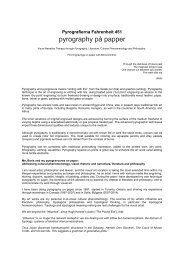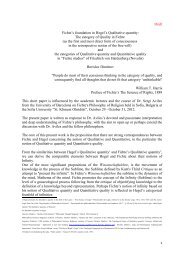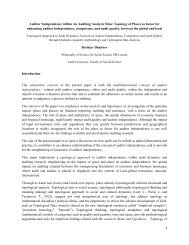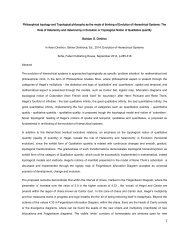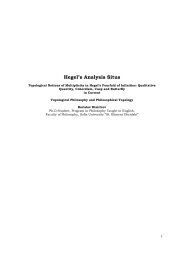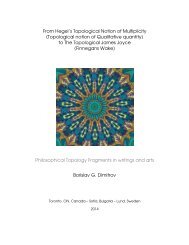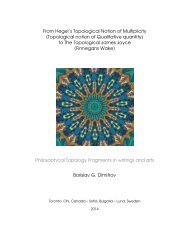Topological Ontology and Logic of Qualitative quantity
Qualitative quantity and BFO (Basic Formal Ontology) of /Barry Smith/ and YAMATO (Yet Another More Advanced Top-level Ontology) of /Riichiro Mizoguchi/
Qualitative quantity and BFO (Basic Formal Ontology) of /Barry Smith/ and YAMATO (Yet Another More Advanced Top-level Ontology) of /Riichiro Mizoguchi/
- No tags were found...
You also want an ePaper? Increase the reach of your titles
YUMPU automatically turns print PDFs into web optimized ePapers that Google loves.
agreements about the representation <strong>of</strong> particular domain theories. In the knowledge<br />
sharing context, topological ontology <strong>of</strong> qualitative <strong>quantity</strong> deserve own place into the<br />
form <strong>of</strong> definitions <strong>of</strong> representational vocabulary.<br />
The new area <strong>of</strong> interdependence between the quality <strong>and</strong> <strong>quantity</strong> is open now for<br />
rethinking <strong>and</strong> reconceptualization. In <strong>Qualitative</strong> Spatial Representation in the field <strong>of</strong><br />
<strong>Qualitative</strong> Spatial Reasoning, the term “qualitative quantitative space” emerged <strong>and</strong> the<br />
concept <strong>of</strong> “qualitative <strong>quantity</strong>” is vitally accepted <strong>and</strong> utilized. 5 <strong>Qualitative</strong> <strong>quantity</strong> seen<br />
in Poincare’s topology <strong>and</strong> his development <strong>of</strong> the qualitative theory <strong>of</strong> differential<br />
equations is enhanced by the new science <strong>of</strong> Mereotopology, which began with theories<br />
A.N. Whitehead articulated in several books <strong>and</strong> articles he published between 1916 <strong>and</strong><br />
1929. Mereotopology is a branch <strong>of</strong> metaphysics, <strong>and</strong> ontological computer science, a firstorder<br />
theory, embodying mereological <strong>and</strong> topological concepts, <strong>of</strong> the relations among<br />
wholes, parts, parts <strong>of</strong> parts, <strong>and</strong> the boundaries between parts. The <strong>Qualitative</strong> <strong>quantity</strong> is<br />
the base cathegory <strong>and</strong> phenomenom <strong>of</strong> <strong>Qualitative</strong> research /QR/, due to the aim <strong>of</strong> QR to<br />
utilise methods that seek to discern the quality — as opposed to the <strong>quantity</strong> — <strong>of</strong> its<br />
subject. <strong>Qualitative</strong> <strong>quantity</strong> is critical in Spatial-temporal reasoning applicable in computer<br />
science as Visual thinking <strong>and</strong> Visual music, Visual statistic /the series <strong>of</strong> works by David<br />
James Krus/.<br />
<strong>Ontology</strong> in philosophy means theory <strong>of</strong> existence. <strong>Ontology</strong> tries to explain what is being<br />
<strong>and</strong> how the world is configured by introducing a system <strong>of</strong> critical categories to account<br />
things <strong>and</strong> their intrinsic relations. The origin <strong>of</strong> philosophical ontology is Aristotle’s<br />
metaphysics <strong>and</strong> his theory <strong>of</strong> categories, intelligible universals extending across all<br />
domains. According to Aristotle the world is organized via types/universals/categories<br />
which are hierarchically organized. The historical line goes from Aristotle trough the<br />
Medieval scholastics, such as Aquinas, Scotus, Ockham, from Descartes <strong>and</strong> Kant to<br />
Brentano’s rediscovery <strong>of</strong> Aristotle to Ednund Husserl, the inventor <strong>of</strong> formal ontology as a<br />
discipline distinct from formal logic, who showed how philosophy <strong>and</strong> science had become<br />
detached from the ‘life world’ <strong>of</strong> ordinary experience, claiming that the methods <strong>of</strong><br />
philosophy <strong>and</strong> <strong>of</strong> science are one <strong>and</strong> the same. The historical line <strong>of</strong> ontology is continued<br />
by Wittgenstein, Vienna Circle (Schlick, Neurath, Gödel, Carnap, Gustav Bergmann), British<br />
Ordinary Language philosophy (Speech Act Theory <strong>of</strong> J. L. Austin), Quine’s ontological<br />
commitment, Analytical metaphysics <strong>of</strong> Chisholm, Lewis, Armstrong, Fine, Lowe. This line<br />
ends with the beginnings <strong>of</strong> a rediscovery <strong>of</strong> metaphysics as first philosophy.<br />
1. <strong>Topological</strong> backgroung <strong>of</strong> Edmund Husserl’s <strong>Ontology</strong> – <strong>Topological</strong>,<br />
Mereological <strong>and</strong> Mereotopological Part-Whole Reasoning<br />
Edmund Husserl’s formal ontology is the natural environment <strong>of</strong> topology <strong>and</strong> topological<br />
background <strong>of</strong> Husserl’s work. Husserl's “<strong>Logic</strong>al Investigations” (1900/01) contain a<br />
formal theory <strong>of</strong> part, whole <strong>and</strong> dependence that is used by Husserl to provide a<br />
framework for the analysis <strong>of</strong> mind <strong>and</strong> language <strong>of</strong> just the sort that is presupposed in the<br />
idea <strong>of</strong> a topological foundation for cognitive science. 6<br />
One <strong>of</strong> the most sophisticated scientists <strong>and</strong> researcher who strongly support the idea <strong>of</strong><br />
topological Husserl 7 is Barry Smith, Pr<strong>of</strong>essor <strong>of</strong> Philosophy, Neurology <strong>and</strong> Computer<br />
Science <strong>and</strong> Director <strong>of</strong> the National Center for Ontological Research at the University at<br />
5<br />
See: A. G. Cohn, <strong>Qualitative</strong> Spatial Representation <strong>and</strong> Reasoning Techniques, Division <strong>of</strong> Artificial<br />
Intelligence, School <strong>of</strong> Computer Studies, University <strong>of</strong> Leeds.- Note 1.’footnote’ about “qualitative <strong>quantity</strong>”.<br />
6 Barry Smith, <strong>Topological</strong> Foundations <strong>of</strong> Cognitive Science, a revised version <strong>of</strong> the introductory essay in C.<br />
Eschenbach, C. Habel <strong>and</strong> B. Smith (eds.), <strong>Topological</strong> Foundations <strong>of</strong> Cognitive Science, Hamburg:<br />
Graduiertenkolleg Kognitionswissenschaft, 1994, the text <strong>of</strong> a talk delivered at the First International Summer<br />
Institute in Cognitive Science in Buffalo in July 1994.: http://ontology.buffalo.edu/smith/articles/topo.html<br />
And Barry Smith, (ed.) 1982 Parts <strong>and</strong> Moments. Studies in <strong>Logic</strong> <strong>and</strong> Formal <strong>Ontology</strong>, Munich: Philosophia.)<br />
3





